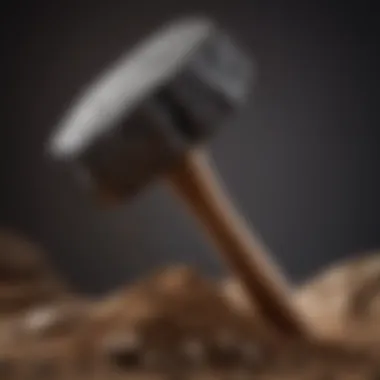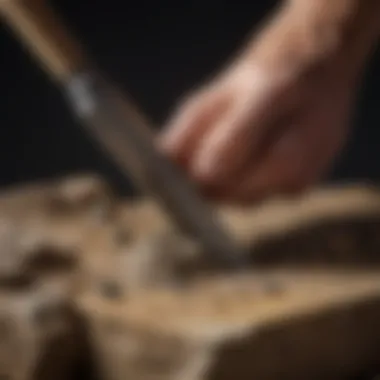Mastering the Art of Rock Digging Tools: A Comprehensive Guide for Collectors


Rock and Fossil Identification
Rock and fossil identification is a fundamental aspect of the collector's journey. Understanding the types of rocks and fossils, along with the key characteristics to look for, is crucial in building a comprehensive collection. Different rocks, such as igneous, sedimentary, and metamorphic, each have distinct features that aid in their identification. Fossils, on the other hand, provide a glimpse into prehistoric life, with varying levels of preservation and detail. To aid in identification, collectors utilize a range of tools, including magnifying glasses, UV lights, and field guides, which enhance the process by magnifying details and providing reference points for comparison.
Collecting Tips and Techniques
Mastering the art of collecting rocks and fossils goes beyond mere excavation; it involves a deep understanding of best practices and techniques. Seasoned collectors know that locating prime collecting sites is essential, as different geological formations harbor distinct specimens. Whether searching in quarries, riverbeds, or mountainous regions, being aware of the geological context is paramount. Safe extraction methods, such as using brushes and small chisels to carefully unearth specimens without causing damage, are key to preserving the integrity of the find. Additionally, employing GPS coordinates and geological maps can aid in tracking and revisiting productive sites.
Preservation and Display
Preservation techniques are critical in maintaining the quality and integrity of collected rocks and fossils. Methods such as cleaning with gentle brushes and storing in acid-free containers help prevent degradation over time. Proper storage, whether in foam-lined boxes or display cases, ensures protection from external elements while allowing for easy retrieval and curation. As collectors amass their finds, creative display ideas come into play, from constructing dioramas that mimic natural settings to utilizing lighting techniques that highlight the details and textures of each specimen.
Geological Insights
Delving deeper into the geological underpinnings of collected rocks and fossils unveils fascinating insights. By recognizing the various geological formations and the processes that shape them, collectors gain a richer appreciation for the specimens in their collection. Understanding the historical significance of certain rocks and fossils, such as those tied to pivotal scientific discoveries or ancient civilizations, adds layers of depth to the hobby. The field of rock and fossil collecting is continuously evolving, with new discoveries shedding light on Earth's history and the creatures that once roamed its landscapes.
Introduction
In the realm of rock digging tools, understanding the significance and utility of these instruments is paramount for enthusiasts and professionals alike. Rock digging tools are the cornerstone of geological exploration, allowing collectors to unearth hidden treasures and specimens with precision and care. As we delve into the comprehensive guide for collectors, we will unravel the essence of these tools, shedding light on their indispensable role in the world of rock and fossil excavation.
Understanding the Importance of Rock Digging Tools
The Role of Tools in Geological Exploration
Tools in geological exploration serve as extensions of the collector's hands, enabling precise and controlled excavation. The significance lies in their ability to extract specimens from the earth without causing damage, ensuring preservation of delicate rocks and fossils. One key characteristic of these tools is their durability and ergonomic design, which streamline the digging process, making them a popular choice among collectors. The unique feature of these tools is their versatility, allowing collectors to navigate various terrains and geological formations with ease.
Preservation of Specimens
Preserving specimens is crucial in maintaining the integrity and scientific value of collected rocks and fossils. Through the use of specialized tools such as brushes and delicate chisels, collectors can carefully extract and clean specimens without compromising their structure. The key characteristic of preservation tools is their precision and gentleness, ensuring that valuable specimens remain intact throughout the excavation process. While these tools require careful handling, their advantage lies in their ability to safeguard the authenticity and beauty of collected specimens.
Overview of Equipment
Essential Tools for Rock Collectors
Essential tools for rock collectors encompass a range of instruments, from sturdy rock hammers to precision chisels. These tools provide the foundation for successful excavation, allowing collectors to break rock layers and extract specimens with accuracy. The key characteristic of essential tools is their durability and efficiency, making them essential companions for collectors in the field. Their unique feature lies in their versatility, as they cater to various types of rocks and fossils, enhancing the collector's ability to uncover hidden treasures.


Advanced Equipment for Professional Excavation
For professionals and advanced collectors, specialized equipment such as geological picks and sifting screens are indispensable for detailed excavation. The key characteristic of advanced equipment is their precision and advanced functionality, allowing collectors to perform intricate tasks with ease. The unique feature of these tools is their specialized nature, designed to meet the demanding requirements of professional excavation. While they may require additional expertise to operate, their advantage lies in their ability to unveil intricate details and features of geological specimens.
Rock Excavation: Unleashing the Power of Digging Tools
Basic Tools for Beginners
In the vast world of rock and fossil collection, having a solid understanding of basic tools is crucial for enthusiasts looking to kickstart their journey into geological exploration. The significance of acquiring knowledge about essential tools cannot be overstated, as these foundational instruments lay the groundwork for successful excavation and specimen preservation. Novice collectors often underestimate the importance of starting with the right tools. However, investing time in familiarizing oneself with basic equipment such as rock hammers, chisels, and safety gear is a wise decision that can enhance the overall rock digging experience.
Rock Hammer
Features and Functions
The rock hammer stands as the cornerstone of any rock collector's toolkit, known for its versatility and durability. Its key features include a flat hammering surface for breaking rocks, a sharp pick for prying, and a sturdy handle for comfortable grip and control. This tool's dual functionality in splitting and excavating rocks makes it indispensable for various geological tasks, from amateur rockhounding to professional excavations. Its rugged construction enables users to tackle even the toughest rocks with ease, ensuring efficiency in extraction and collection.
Choosing the Right Hammer for Your Needs
Selecting the appropriate rock hammer entails considering factors such as weight, handle material, and head size to align with specific excavation requirements. For beginners, a lightweight hammer with a fiberglass handle and a medium-sized head is recommended for easy handling and reduced fatigue during prolonged use. More experienced collectors might opt for heavier hammers with steel handles for increased striking force and durability. Understanding one's preferences and intended use cases is essential in choosing the right rock hammer that matches individual needs and excavation goals.
Chisels
Types of Chisels
Chisels come in various shapes and sizes, each designed to serve a particular purpose in rock excavation. From flat chisels for splitting and trimming rocks to pointed chisels for precise detailing work, understanding the distinct characteristics of each type is fundamental for efficient and accurate chiseling tasks. Novice collectors benefit from starting with a set of basic chisels that cover a range of functionalities, allowing them to experiment and learn the nuances of chiseling techniques.
Safety Tips for Chiseling
Chiseling rocks requires precision and control to avoid injury and damage to specimens. Safety tips such as wearing protective goggles to shield eyes from flying debris, using proper hand positioning to prevent accidents, and securing rocks before chiseling for stability are essential practices to ensure a safe and productive excavation process. Novice collectors should prioritize safety measures and gradually develop their chiseling skills to minimize risks and maximize the longevity of their tools.
Safety Gear
Protective Eyewear
Protective eyewear is a non-negotiable safety accessory for rock collectors, as it safeguards the eyes from potential hazards such as rock chips, dust, and sharp fragments. Opting for impact-resistant goggles with side shields offers comprehensive protection, ensuring clear vision and minimizing the risk of eye injuries during excavation activities. Prioritizing eye safety with quality protective eyewear enhances both the efficiency and safety of rock digging endeavors.
Gloves and Clothing


In addition to eye protection, wearing appropriate gloves and clothing is vital for safeguarding the hands and body while handling rocks and tools. Durable gloves made of cut-resistant material provide a barrier against sharp edges and rough surfaces, reducing the likelihood of cuts and abrasions. Choosing breathable and flexible clothing that covers exposed skin minimizes the impact of prolonged exposure to elements and enhances overall comfort during extended excavation sessions. Adhering to proper safety gear protocols ensures a holistic approach to maintaining personal safety and well-being throughout the rock collecting process.
Specialized Tools for Advanced Collectors
When it comes to the realm of rock and fossil collection, advanced collectors understand the significance of utilizing specialized tools that elevate their excavation experience to new heights. These sophisticated tools not only aid in precision and efficiency but also allow collectors to delve deeper into their craft with meticulous detail and care. In this section of the comprehensive guide, we will explore the specific elements, benefits, and considerations surrounding specialized tools for advanced collectors, shedding light on the crucial role they play in the world of geological exploration and preservation.
Geological Pick
Design and Usage
The geological pick stands out as a cornerstone tool for advanced collectors due to its robust design and versatile usage. With a pointed tip on one end and a chisel-like edge on the other, the geological pick is highly adept at breaking rocks and extracting specimens with utmost precision. Its ergonomic handle provides a comfortable grip, allowing collectors to work for extended periods without fatigue. This design ensures that collectors can navigate through varied terrains and rock formations with ease, making it a popular choice for professionals seeking efficiency and durability in their excavations.
Benefits of a Geological Pick
The geological pick offers a multitude of benefits that contribute to its prominence in the toolkit of advanced collectors. Its sturdy construction and sharpened edges allow for effortless rock splitting and chiseling, enabling collectors to access hidden treasures within rocky pockets. Moreover, the pick's ability to withstand rugged conditions enhances its longevity, making it a reliable companion for long-term excavation projects. Its lightweight yet sturdy build strikes a balance between portability and functionality, ensuring that collectors can intricately maneuver through delicate rock layers without causing damage to specimens. These combined benefits make the geological pick an indispensable tool for advanced collectors seeking to elevate their excavation skills to the next level.
Sifting Screens
Types of Screens
Sifting screens play a pivotal role in the rock collection process by facilitating efficient specimen separation and categorization. These screens come in various mesh sizes, each serving a distinct purpose in filtering out debris and isolating valuable specimens. From coarse screens for initial rough sorting to fine screens for detailed sifting, collectors can employ a range of screens to streamline their rock excavation efforts. The versatility and adaptability of sifting screens make them a valuable asset for advanced collectors looking to enhance their precision and organization during fieldwork.
Techniques for Efficient Filtering
Effective filtering techniques are essential for maximizing the utility of sifting screens in the rock collection process. By employing strategic shaking and agitation methods, collectors can ensure thorough separation of materials based on size, density, and composition. Additionally, the use of water or air flow can aid in the separation of lighter particles from heavier specimens, allowing for precise sorting and classification. Understanding and implementing efficient filtering techniques not only expedite the specimen identification process but also preserve the integrity of delicate specimens, making sifting screens a cornerstone tool for meticulous collectors seeking optimal results in their excavation endeavors.
Portable Microscope
Magnification Levels
A portable microscope offers advanced collectors the capability to examine minute details and structures invisible to the naked eye, providing a closer look at the geological intricacies embedded within specimens. With varying magnification levels ranging from 20x to 200x, collectors can zoom in on specific features, enhancing their understanding of mineral composition, texture, and fossil characteristics. The portability of these microscopes allows for on-the-go analysis, enabling collectors to conduct in-field assessments and quick identifications with precision and convenience.
Examining Microscopic Details
The ability to examine microscopic details through a portable microscope presents a transformative experience for advanced collectors, offering insights into the hidden world within specimens. By scrutinizing tiny features such as crystal formations, fossil imprints, and mineral patterns, collectors can unravel the geological history encapsulated within rocks and fossils. The high-resolution imaging and adjustable focus of portable microscopes enable collectors to capture and document intricate details for further analysis and record-keeping, making them an indispensable tool for in-depth exploration and documentation of geological finds.


Maintenance and Care of Tools
In the realm of rock digging tools, the topic of maintenance and care holds significant importance. Ensuring proper maintenance and care of tools not only prolongs their lifespan but also enhances their effectiveness during excavation endeavors. Rock collectors recognize the essential role that maintenance and care play in upkeep and performance. By dedicating attention to the maintenance of tools, collectors can optimize their functionality in uncovering geological specimens and fossils.
Cleaning and Storage
Removing Debris
Removing debris from rock digging tools is a crucial aspect of maintenance. It contributes to the overall longevity and efficiency of the tools, preventing unnecessary wear and tear. By regularly removing debris, collectors can sustain the sharpness and functionality of their tools, allowing for precise and effective excavation. The unique characteristic of effective debris removal lies in its ability to preserve the integrity of the tools, ensuring they remain in optimal working condition for extended periods. This diligent practice of removing debris also minimizes the risk of damage to the specimens being extracted, showcasing its essential role in the field of rock collecting.
Preventing Rust
Another vital aspect of tool maintenance is preventing rust, which is a common concern due to the exposure of tools to various environmental conditions. Preventing rust is essential for maintaining the structural integrity of the tools and safeguarding their performance. By implementing rust prevention techniques, collectors can prolong the lifespan of their tools and prevent corrosion that could affect their functionality. The key characteristic of effective rust prevention methods is their ability to create a protective barrier on the tools, shielding them from moisture and oxidation. Although preventing rust requires regular attention and care, the benefits of preserving the tools' quality and performance far outweigh the time and effort invested in this maintenance practice.
Sharpening Techniques
Maintaining Sharp Edges
One essential aspect of tool maintenance for rock collectors is the practice of maintaining sharp edges. Sharp edges are integral to the efficiency and precision of rock digging tools, allowing collectors to extract specimens with accuracy and ease. By routinely sharpening and maintaining the edges of their tools, collectors can ensure consistent performance and optimal results during excavation activities. The key characteristic of maintaining sharp edges is the enhancement of cutting and chiseling capabilities, enabling collectors to work proficiently with various types of rocks and fossils. This practice of edge maintenance contributes to the overall success of excavation endeavors, facilitating the extraction of specimens with minimal damage and maximum accuracy.
Tools for Sharpening
Equally important in the realm of tool maintenance is the availability of suitable tools for sharpening. Rock collectors rely on specialized sharpening tools to uphold the sharpness of their digging equipment. Choosing the right tools for sharpening is paramount in ensuring that the edges of rock hammers, chisels, and other implements remain precise and effective. The unique feature of quality sharpening tools lies in their ability to maintain the integrity of the tool edges without compromising their strength. Collectors benefit from using dedicated sharpening tools that are tailored to the material and properties of their rock digging equipment, enhancing the overall performance and longevity of their tools.
Conclusion
In the realm of rock digging tools, the Conclusion section draws together the essence of this comprehensive guide. As collectors delve into the world of geological exploration, mastering the art of using the right tools becomes paramount. The Conclusion serves as a crucial endpoint, emphasizing the significance of honing one's skills to navigate through various terrains and unearth hidden treasures successfully. It encapsulates the essence of the entire article, urging collectors to apply their knowledge diligently and continue their pursuit of uncovering the mysteries that lie beneath the earth's surface.
Mastering the Art of Rock Digging
Enhancing Your Collection
Exploring the aspect of Enhancing Your Collection adds a layer of depth to the overall topic of rock digging tools. For collectors seeking to build a diverse and impressive collection of rocks and fossils, this section provides valuable insights. By enhancing their collection, enthusiasts can showcase a wide array of specimens that capture the beauty and diversity of the earth's geological wonders. The key characteristic of Enhancing Your Collection lies in its ability to enrich the collector's understanding of geological formations and processes, making it a popular choice among avid rock and fossil enthusiasts.
Moreover, the unique feature of Enhancing Your Collection is its capacity to offer a broader perspective on the natural world. This not only enhances the visual appeal of a collection but also deepens the collector's knowledge and appreciation for the earth's history. While there may be challenges in sourcing rare or unique specimens, the advantages of enhancing one's collection far outweigh any obstacles. In this article, Enhancing Your Collection serves as a cornerstone for collectors to elevate their passion and showcase the beauty of geological discoveries.
Continuous Learning and Exploration
Within the realm of Continuous Learning and Exploration, collectors are encouraged to embrace a lifelong journey of discovery. This aspect contributes significantly to the overall goal of expanding one's knowledge and expertise in rock and fossil collecting. By continuously seeking new information, techniques, and locations for excavation, enthusiasts can nurture their curiosity and deepen their understanding of geological processes.
The key characteristic of Continuous Learning and Exploration lies in its dynamic nature, offering endless opportunities for growth and enrichment. This quality makes it a popular choice among collectors who value intellectual stimulation and personal development. Engaging in continuous learning not only broadens one's skills but also fosters a sense of community among fellow collectors, creating a network of individuals passionate about rocks and fossils.
The unique feature of Continuous Learning and Exploration is its capacity to spark creativity and innovation in collecting practices. By staying curious and open to new experiences, collectors can pioneer novel approaches to excavation and specimen preservation. While there may be challenges in accessing new information or resources, the advantages of cultivating a mindset of continuous learning far outweigh any limitations. In this article, Continuous Learning and Exploration stands as a testament to the endless possibilities that await those who are committed to enriching their knowledge and skills in rock and fossil collection.







